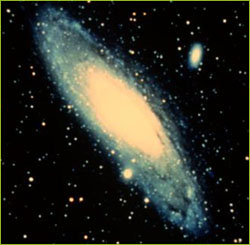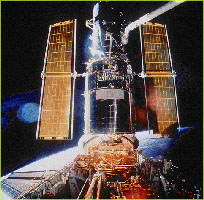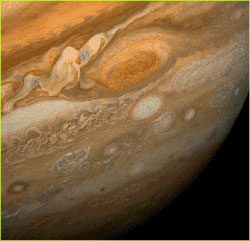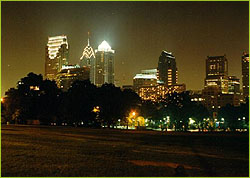
|

|

Be a Stargazer
(It's easy)
Today's planet hunters use Doppler spectroscopy and billion
dollar telescopes to detect distant worlds. But all you need
to be a stargazer are your naked eyes. On a clear night,
looking skyward from a dark location, you can spot Venus and
Jupiter, see the streak of our Milky Way, and even glimpse
another galaxy two-million light years from the Earth.
Less Than Hubble-Vision
 While the view may be breathtaking, it's a tiny fraction
of the universe. Naked-eye sky watchers, even under the best
conditions, can count only about 3,000 of the billions and
billions of stars in the cosmos. While the view may be breathtaking, it's a tiny fraction
of the universe. Naked-eye sky watchers, even under the best
conditions, can count only about 3,000 of the billions and
billions of stars in the cosmos.
Our vision is limited by the amount of light that can pass
through the human eye. The pupil of an eye acts like the
aperture of a camera. In the dark of night the pupil opens
to about 8 mm in diameter. By contrast, the front lens of a
common binocular used by amateur astronomers is about 50 mm
in diameter. Binoculars and telescopes help stargazers by
increasing the amount of light that is funneled to the
eye—allowing perception of fainter objects.
 These optical aids also magnify celestial
objects—giving sky watchers a clear view of the
craters on the moon and the red spot of Jupiter. But
magnification is less critical than light collection for
simple stargazing. And binoculars and telescopes with
powerful magnification require mounts to hold images
steady. These optical aids also magnify celestial
objects—giving sky watchers a clear view of the
craters on the moon and the red spot of Jupiter. But
magnification is less critical than light collection for
simple stargazing. And binoculars and telescopes with
powerful magnification require mounts to hold images
steady.
With a small telescope, and a stable mount, you can discover
the rings of Saturn and the moons of Jupiter. With the most
advanced telescopes, like Hubble, astronomers can look
billions of light years into space and glimpse the birth of
the universe.
Stargazing Tips
Get Where It's Dark

The glow of city lights brightens the sky and obscures our
view. City smog also dims starlight. So, the best
stargazing spots are far from a crowd.
Just Look Up
When you gaze straight up toward the zenith, you are
looking through about five miles of Earth's atmosphere.
Toward the horizon, you look through many tens of miles of
atmosphere—through turbulent gases that filter light
and cause stars to twinkle. This difference in atmospheric
depth is why the midday sun, high in the sky, appears much
brighter than at sunset. (The setting sun is also red
because the atmosphere reduces blue light more than red
light.)
Sensitize Your Eyes
When you step from a bright room to the dark outdoors,
your pupils widen immediately. But cells in the retina may
take 15 minutes to a half an hour to become dark adapted.
Be patient, and try not to look at any bright white
lights. Red light does not affect this adaptation. (Think
of the red taillights of a car.) So, if you need a
flashlight, try using a red bulb or cellophane filter.
Know What to Find
Remember that the night sky is constantly changing! What
you see depends on your location on earth, the time of day
or night, and the time of year. Star maps and other guides
can tell you what to expect from your vantage point.
Further ideas on amateur astronomy
Photos (1), (3) copyright © NASA; (2) copyright ©
STScI/NASA; (4) copyright ©
Vickie M. Feldman
Worlds Home |
Alone? |
Stargazer
Constellations
| Star Map |
Planets
Life
| Resources |
Table of Contents
|
|
|